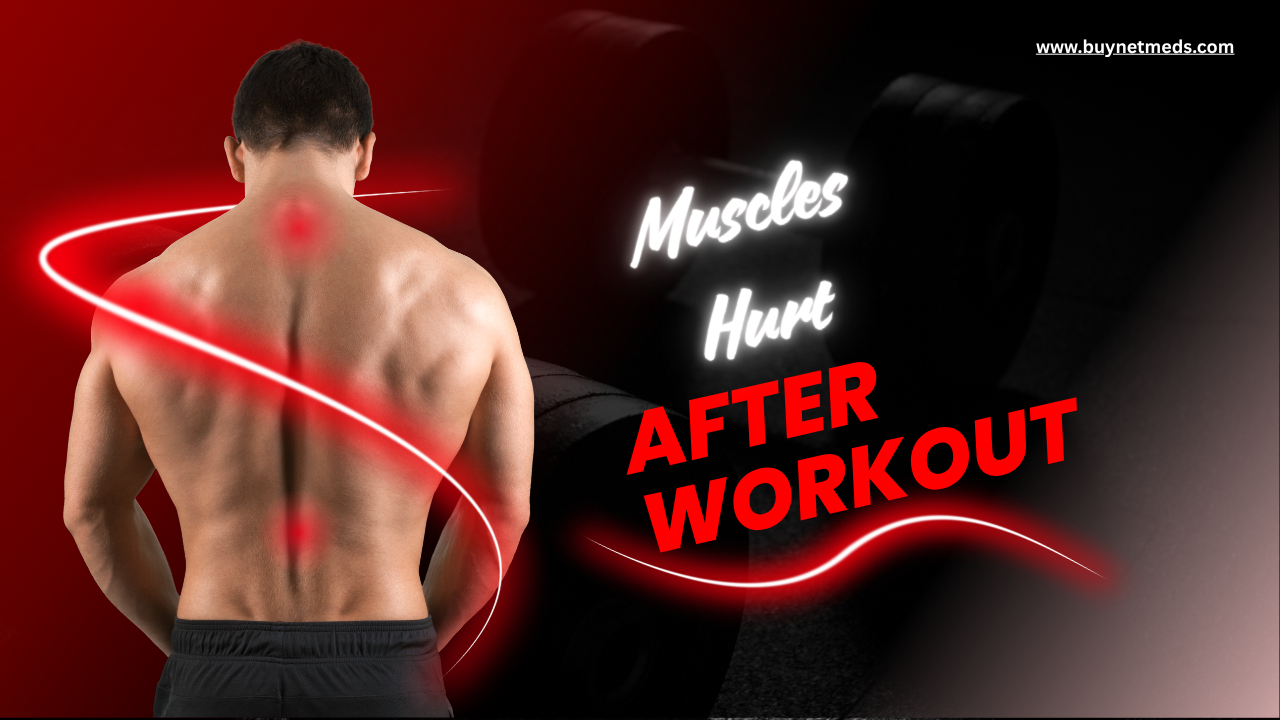After working out, small tears are created in the muscle that induce delayed onset muscle soreness. This is normal with intense or new workouts, as it indicates that the muscles are adapting to the new demands placed upon them. Mild soreness can be good, but severe pain might be a symptom of an injury. Understanding the causes, remedies, and warnings will aid in recovery. This article looks at why muscle soreness occurs, offers some tips for relieving soreness, and tells you when to get medical attention for safe and healthy working out.
What Causes Muscle Pain After a Workout?
After an intense or unfamiliar workout, you might feel that your muscles get stiff and sore for about a day or two. This is due to Delayed Onset Muscle Soreness (DOMS), where stiffening from heavy exercises creates microscopic tears in the muscle fibres. Your body’s natural recovery from this process involves inflammation, which peaks at about 24 to 72 hours post-workout, resulting in second-day discomfort.
Some people think that lactic acid causes long-lasting soreness, but it is washed away soon after you finish exercising. The real culprit for DOMS is a small muscle rupture – again, when healed, these muscles become stronger.
You will most often experience muscle soreness when you start new exercise routines or intensify your current workouts. For some relief, consider easy-to-do activities such as gentle stretching or walking, drinking plenty of water, and simply resting. However, if the pain becomes intolerable, then you had better fabulous down absolutely, rest up, and modify your schedule accordingly.
Just remember, soreness is a regular part of gaining strength, but listening to your body is what will keep you safe and moving forward!
Is Muscle Pain After a Workout Good or Bad?
As a matter of course, the frequent soreness after working out is a sign of muscle strengthening. If the pain persists or continues too long, an underlying injury may be the case, and it would be best to go to a doctor for a check-up. Meanwhile, it’s a good idea to keep hydrating and well-resting, so your muscles can recover.
Good Muscle Soreness vs. Bad Muscle Pain
Low-level muscle aches after a workout are, in fact, helpful in strengthening muscles. The discomfort generally peaks anywhere between 24 and 72 hours after a workout and then slowly fades.
However, should this pain turn severe, persistent, or unbearable, it must be taken as an indication that the body has been overworked; incorrect form could have been used, or an injury might have been sustained. No more activity should be undertaken until the body can heal from this level of trauma.
Knowing the distinction between everyday muscle aches and severe pain is essential because they feel pretty different. Adjust your workouts accordingly in terms of intensity and technique to optimise your results.
Hydrate well during your recovery; stretch frequently, and get enough sleep. Ignore intense pain, and your gains will potentially suffer, and injuries will become a high risk.
Does muscle pain mean a good workout? (Not always)
Post-exercise soreness doesn’t necessarily mean that maximum gains were; the mild case of soreness could indicate growth, while a sharp pain could be heralding an injury. The pleasure of workouts comes from striking the right balance of intensity and allowing adequate rest between them. Consult a doctor for any pain that is severe or that appears to be lingering. Any interventions for soreness and enhanced performance should emphasise warm-up, good hydration, and sufficient recovery time.
No muscle pain after workout – Does it mean no gains?
Muscle pain in the days following a workout is known as DOMS, or delayed-onset muscle soreness. The muscle is adapting, which is normal but not necessary for progress. You can still achieve results without soreness as long as you work out with adequate intensity, good form, and recovery. Soreness alone DOES NOT build muscle; it’s consistent effort. Mild soreness is normal; however, if the muscle soreness comes with all sorts of pains, it means that you have gone too far. Aim for strength gains instead of the feel-good soreness.
Types of Post-Workout Muscle Pain

Normal Soreness
The type of muscle pain a person feels after a workout may be considered either normal soreness or excessive. Tiny muscle tears lead to such fatigue after working out that may not be regarded as undue. The pain usually peaks after two or three days and begins to subside slowly as the muscles start to heal. The pain in this soreness is said to be a positive indication of your training methods. Managing your hydration levels, stretching, and ensuring proper rest will help you to cope with the pain and develop muscle strength.
Extreme Muscle Pain After Workout
This involves the two types of muscular discomfort most commonly experienced by people after exercising: immediate soreness and soreness one or two days later, widely referred to as delayed-onset muscle soreness. If you have aches after completing your first workout, chances are that you have DOMS brought on by a fresh strain. If the pain is intense, it is a warning sign that you may have overstressed and injured the muscles. Rest and consultation with a physician are advised for any sharp pain that does not dissipate. Smooth, warm-ups followed by gradual increases in intensity are great remedies for avoiding unnecessary soreness.
Localised Pain (e.g., Legs, Quads, Back)
Anything related to workout soreness is usually specific to particular body areas, such as the legs, the quads, or even the back. A leg muscle usually starts hurting after high-intensity lower-body exercises; meanwhile, quad muscle pain mostly comes after doing squats and lunges, and even with a knee replacement, weak quads can cause an aching sensation. Back pain in the upper back, arising from poor form during rowing or shoulder press, is standard. Prevention is a matter of warming up, hydrating well, and taking it easy at the beginning of the exercise. Stretching and resting are all part of recovery, too.
Other Conditions
After a workout, muscle pain is usually classified as either acute (occurring right after exercise) or delayed onset muscle soreness (DOMS), which develops 1–3 days later. DOMS happens when microscopic muscle fibres break down during intense or unfamiliar exercise. People with fibromyalgia often experience prolonged pain and exhaustion after physical activity. For those who’ve been inactive, initial workouts may be uncomfortable as the body needs time to adapt. Starting with gentle warm-ups and staying hydrated can help minimise discomfort.
When Should You Be Concerned?
Signs of overtraining or injury:
Avoid overexertion, as it can cause the muscles to become overfatigued, leading to prolonged recovery periods. Sore muscles accompanied by a fever may be an indication of an infection or rhabdomyolysis. Severe cramping may indicate dehydration or a loss of minerals. Listen to your body. If the symptoms do not worsen or go away, rest or seek help from a medical practitioner. Listen to those signs early; that way, you will be protected.
Is it bad if your body hurts after working out? (When to see a doctor)
A slight stiffness the morning after a challenging workout is par for the course, especially for newcomers or folks trying a heavier lift than usual. That echoing ache, known as delayed-onset muscle soreness (DOMS), typically reaches its peak between 24 and 72 hours later and then subsides. If the soreness develops into sharp, lingering pain that lasts longer than a week or is accompanied by swelling, redness, or joint trouble, a doctor’s visit is warranted. The same goes for that quick stab of discomfort you feel mid-set; that’s often a sign that something is hurt. In short, give your body warning bells the respect they deserve.
How to Relieve Muscle Pain After a Workout
Immediate Relief Methods
What is good for muscle pain after a workout?
Switching between ice packs and warm towels gives sore muscles a quick wake-up call and flushes out the stiffness. A few stubborn knots will often yield to five minutes of foam rolling. Drinking water, sleeping well, and, when discomfort spikes, reaching for an over-the-counter pain pill keep the recovery curve on track. Even a casual stroll around the block keeps the blood flowing and fatigue at bay. If you make these small habits part of every routine, tomorrow’s soreness won’t sting nearly as much.
Long-Term Recovery Strategies
If your muscles feel cranky after a workout, chug some water and snack on Greek yoghurt or a turkey sandwich so the protein can get to work. A gentle stroll or a few easy stretches keeps the blood flowing through your legs and cuts down on that frozen-in-place feeling. In a pinch, over-the-counter remedies like ibuprofen or a traditional soak with Epsom salt and a sprinkle of turmeric can help alleviate the ache. Never underestimate the importance of regular sleep; the hours spent on a pillow are when your body repairs itself. Add all that up, and your muscles bounce back instead of sitting on the sidelines.
What to do if you have muscle pain after a workout
Once the workout ends, a slow stretch can help loosen tight muscles and encourage fresh blood flow. If a limb swells in the next two days, icing it with a bag of peas can help reduce the puffiness; later on, a soak in warm water can help alleviate the sting. Gulp plenty of water and nibble on a chicken sandwich, yoghurt, or handful of nuts so tired fibres can patch up. A short stroll around the block keeps stiffness from settling in. If the ache refuses to quit, a drugstore pain pill usually helps; still, nothing beats simply lying low and letting the body heal.
Preventing Extreme Muscle Soreness
Nobody enjoys the biting agony that sometimes greets you in the morning after a demanding lift. You can lighten that load with a handful of commonsense habits.
Progress Gradually
Jumping from easy sets into all-out marathons seldom ends well. Gradual jumps in weight, distance, or reps give the fibres a chance to strengthen along with your ambition.
Warm Up and Cool Down Properly
A five-minute, half-hearted stroll on the treadmill barely qualifies as a warm-up. Mobility drills that mimic the moves you’ll soon perform prepare the nervous system and joints more effectively.
Eating Enough Protein
Chicken, Greek yoghurt, beans, or the occasional protein shake act like glue when tiny muscle tears happen. Snag a portion of protein within two hours of finishing to kick-start repair.
Listen to Your Body
A dull ache means you’re working; a sharp twinge means you’re flirting with injury. Shut it down, regroup, then ease back in rather than stubbornly grind through.
Tendon and tissue can bounce back surprisingly fast when common sense drives the routine. Stick with the basics, and you’ll keep moving forward instead of hobbling home.
FAQs
What is the reason behind soreness in muscles when you exercise?
Muscle soreness after exercise, often called delayed onset muscle soreness (DOMS), is caused by microscopic damage to muscle fibres during intense or unfamiliar activity. This triggers inflammation and the release of chemicals that stimulate pain receptors. It typically peaks 24-72 hours post-workout and resolves as muscles repair and adapt.
How much time should you expect the post-workout muscle pain to last?
Post-workout muscle pain, or DOMS (Delayed Onset Muscle Soreness), typically lasts 24 to 72 hours after exercise, peaking around 48 hours. Mild soreness may persist for up to 5 days after intense workouts. Proper hydration, stretching, and gentle activity can help alleviate discomfort and expedite recovery.
Are there chances that Carisoprodol, Tapentadol, and Pregabalin medications effectively treat muscle pain?
Yes, Carisoprodol (a muscle relaxant), Tapentadol (an opioid analgesic), and Pregabalin (an anticonvulsant with pain-modulating effects) can effectively treat muscle pain, depending on the cause. However, they carry risks of dependence, side effects, or misuse, so they should be used cautiously under medical supervision.
How should you prevent or limit muscle soreness and pain?
To prevent or limit muscle soreness and pain, warm up before exercise and cool down afterwards. Stay hydrated, stretch regularly, and gradually increase workout intensity. Incorporate rest days, use proper form, and consider foam rolling or massage. Eating protein-rich foods and anti-inflammatory nutrients (like omega-3s) can also help.
If my body is sore, should I go on with my exercise regimen?
If your body is sore, listen to it. Mild soreness may benefit from light activity or stretching, but intense pain or fatigue signals the need for rest. Overtraining can lead to injury. Adjust your regimen by incorporating lower-intensity exercises or taking a recovery day to allow your muscles to heal.
Should I see a doctor when I experience muscle pain?
If the muscle ache hits you like a bolt, lasts more than seven days, or exhibits symptoms such as swelling, redness, fever, or an unexplained weight loss, a doctor’s visit is a smart move. The same goes for pain that’s proven bad news: after a fall, a new medicine, or any infection that you’ve had. Regular soreness from working out usually fades once you take a break and allow your body time to recover.
Is the pain extreme and sharp, not just a gentle soreness?
Sudden shockwaves of hurt run across my side, way worse than the dull ache I thought I’d shake off. Every jolt feels like someone jabbed me with a lit poker, and for a moment, I can’t breathe. Doctors usually say that kind of blast hints at a fresh tear, a pinched nerve, or some serious trouble that can’t wait.
Conclusion
When you push your muscles in the gym, microscopic tears pop up in the fibres; that’s what many trainers shorthand as microtrauma. In the following day or two, those tiny rips swarm your nervous system, and the dull ache that settles in is called Delayed Onset Muscle Soreness, or DOMS. There’s nothing unusual about it; even seasoned lifters feel the sting, so try not to freak out when climbing stairs suddenly feels heroic. If the soreness drags on or the pain sharpens, however, it could be a red flag that you’ve overshot your limits. A brisk warm-up, a gentle cooldown, plenty of water, and generous recovery breaks are the simplest fixes for smoothing the bumpy road of progress.



